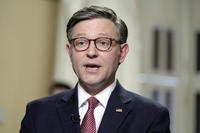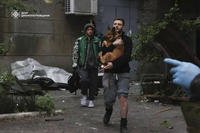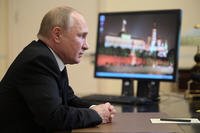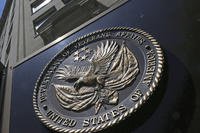Joseph V. Micallef is a best-selling military history and world affairs author, and keynote speaker. Follow him on Twitter @JosephVMicallef.
It has been a little more than a year since the outbreak of the COVID-19 pandemic in the Chinese city of Wuhan was first disclosed. Since then, some 26.1 million Americans have been infected with the COVID-19 virus, and more than 439,0000 have died. Worldwide, 103 million people have come down with COVID-19, and 2.2 million have died from it.
The U.S. has gone through an extensive shutdown with, at its peak on April 7, 2020, roughly 93% of Americans "sheltering in place." Nine months later, a majority of Americans are still living under some form of safer-at-home recommendation and/or restrictions on public gatherings.
The development and distribution of COVID-19 vaccines have emerged as a source of diplomatic rivalry between the United States and China -- and, to a lesser extent, Russia. A looming vaccine shortage has also generated what the World Health Organization, or WHO, is calling "vaccine nationalism" -- a scramble to secure sufficient supplies.
The European Union, or EU, after being advised by manufacturers Pfizer and AstraZeneca that they would be unable to meet their commitment for vaccine deliveries in the first quarter, has imposed restrictions on vaccine exports. The United Kingdom is considering the same.
Are there national security implications to the U.S. from how the vaccine rollout is handled internationally, and will the vaccines become a new point of friction between Washington, Beijing and Moscow?
The State of COVID-19 Vaccination
As of the end of January 2021, two COVID-19 vaccines have been given emergency authorization by the U.S. Food and Drug Administration: one from Pfizer/BioNTech and the other from Moderna. A third vaccine from Oxford-AstraZeneca is expected to be approved by the FDA in February. It has already been approved by the EU for distribution in Europe. A fourth vaccine, from Johnson & Johnson, is expected to be approved by March or April. There are also additional vaccines and therapies being developed by other, smaller companies.
In addition, the People's Republic of China has approved COVID-19 vaccines from two Chinese companies: Sinovac and Sinopharm. Two additional vaccines from CanSino Biologics and Anhui Zhifei Longcom are under development. The Russian Federation has approved a vaccine, Sputnik 5, developed by the Gamaleya National Center of Epidemiology and Microbiology, a Russian research institute that dates back to 1891.
The Chinese vaccines are based on the traditional technique of taking viruses that have been killed and injecting them into a human body. Killing the virus reduces the risk of infecting the subject, although it has been known to happen in rare cases and induces the body to produce antibodies that will confer a high degree of protection against the disease.
The Russian offering is an adenovirus vaccine. Adenoviruses, found in the adenoids, cause acute respiratory infections and are quite common. In such a vaccine, an adenovirus is genetically altered to contain genetic material from the target virus, while at the same time the gene responsible for replication is removed to prevent the virus from duplicating itself and spreading. When this viral vector is injected into a human body, it triggers the production of antibodies.
The Moderna and Pfizer options are mRNA vaccines, a new type that has never been used before. In this case, a segment of the coronavirus genetic code is injected into the body. The injection triggers the subject to make some of the viral proteins, but the included genetic material is insufficient to replicate the entire virus. Those viral proteins trigger the production of antibodies that will neutralize SARS-CoV-2, which causes COVID-19.
All of the vaccines currently approved or under development, with the exception of the Johnson & Johnson version, require two doses. That doubles the number of vaccines that have to be produced.
The Pfizer and Moderna vaccines have to be stored at sub-zero temperatures: minus 20 degrees Celsius for the Moderna vaccine and minus 70 degrees Celsius for the Pfizer vaccine. This complicates their distribution and is a particular problem for those parts of the world that lack the appropriate refrigeration infrastructure.
By comparison, the Oxford-AstraZeneca, Sinovac, Gamaleya and Johnson & Johnson vaccines require only conventional refrigeration, making them much easier to ship and distribute.
The vaccines' effectiveness varies widely. The Pfizer and Moderna vaccines are rated at 95% effective and the Sputnik V at 92%, although there are some doubts about the reliability of the Russian data. The Oxford-AstraZeneca vaccine was 62% to 90% effective in Stage 3 trials.
The effectiveness of the Sinovac vaccine ranged from 91% in Stage 3 trials in Turkey to 50% in Brazil, while the Sinopharm vaccine was 86% effective in Stage 3 trials in the United Arab Emirates.
The Johnson & Johnson vaccine was 72% effective, although its effectiveness was only 51% in South Africa and 60% in Latin America Stage 3 trials.
A vaccine's effectiveness measures its success in preventing the disease from developing. More important is its ability to reduce the effects of the disease sufficiently to forestall hospitalization.
In the case of the Johnson & Johnson vaccine, it was 85% effective in forestalling hospitalization. Coupled with the fact that it requires only one dose and conventional refrigeration, that makes the Johnson & Johnson vaccine particularly useful.
Bear in mind, however, that a vaccine's real-world performance usually lags behind the official results.
Moderna has a production capacity of approximately 500 million doses in 2021. Pfizer's estimated production capacity is around two billion doses. Astra-Zeneca aims o produce 700 million doses in the first quarter of 2021, and is targeting a production of more than three billion doses over the course of the year.
It's believed that Sinovac currently has a capacity of around 500 million doses a year, although it is planning to double its capacity. Johnson & Johnson probably has a capacity of 200 to 300 million doses. The production capacity of the smaller pharmaceutical companies is unclear. Some pharmaceutical companies like Merck, which have not developed a vaccine, also have production capacity that could be used to produce COVID-19 vaccines.
Producing billions of vaccine doses is as much an artform as it is a science. With a population of just under eight billion people, the world will need upward of 16 billion vaccine doses, since most of the vaccines require two doses.
Subtract from that number those individuals who have had the disease and recovered, and who may not need a vaccination. But add back a quantity for the inevitable wastage and production issues that will arise, and the number of doses required is probably in excess of 18 billion. If you exempt children from vaccination, that number will be significantly lower but it is still a sizable, multi-year quantity.
Current yearly production capacity is less than half the required doses, and that assumes that vaccine producers have the capacity to scale up production to meet their ambitious targets. Even if you settle for 80% to 85% of the world's population, the threshold level of achieving herd immunity, you are going to need roughly two years to vaccinate everyone.
National Security and COVID-19 Vaccines
The developed world will succeed in vaccinating the bulk of its citizens over the course of 2021. The rest of the world will lag behind into 2022 or even later.
As of Jan. 30, 2021, the U.S. leads the world in total vaccinations at 30 million, followed by China at 23 million, and the U.K. at nine million. Israel has vaccinated 4.7 million people, and India has vaccinated 3.7 million.
As a percentage of the population, Israel leads the world with a rate of 2% of the population per day, followed by the United Arab Emirates at 1%, Serbia at .65% and the U.K. at .53%. The U.S. is currently fifth with a vaccination rate of .39% per day. At that rate, it will take six to eight months to vaccinate every American. From a practical standpoint, that means the U.S. will have achieved a working level of herd immunity by late June, although sporadic outbreaks will continue to persist over the summer.
The fact that the COVID-19 pandemic will persist into the third quarter of 2021 in most developed countries, and well into 2022 if not 2023 in less developed portions of the world, creates several national security concerns for the U.S. These generally fall into three categories: the possibility that the virus could mutate into a variant that current vaccines can't control or is more transmissible, continuing attempts by America's adversaries to sow distrust among Americans about the effectiveness of the vaccines, and political instability in poorer countries that can result in regional conflict and political chaos.
To date, according to the WHO, dozens of different variants of the SARS-CoV-2 virus have been identified. There are probably many more that have not yet been found. This is not unusual because coronaviruses mutate readily. The risk is that a variant could emerge that is either more lethal or more contagious.
Traditionally, the typical evolution of a coronavirus is toward less lethal forms. As epidemiologists like to point out, however, a coronavirus "can get lucky" and mutate into a deadlier variant. The more people who are infected with COVID-19, the greater the probability that a deadlier mutation could emerge. If it is going to take upward of two years to vaccinate the rest of the world, the possibility of a deadlier virus emerging increases proportionately.
A second consideration is transmissibility. As of January, four variants of the SARS-CoV-2 virus have been identified that appear to be more contagious. These are the U.K. variant (B.1.1.7), which caused a massive case spike in the U.K. and Ireland; the South African variant (B.1.351); the Brazilian variant (P.1); and the Southern California variant (CAL.20C).
None of these variants appears to be more lethal, but they do seem to be more easily transmissible. It's estimated that these variants are possibly 50% to 75% more contagious. What does that mean? A single infection of COVID-19 can, on average, give rise to 64 new infections over the space of a week or so. A variant that is 75% more transmissible would give rise to around 1,800 new cases.
It was precisely these rapid and dramatic spikes that were observed in Ireland and the U.K. over the month of December. In Manaus, Brazil, the epicenter of the Brazilian variant, there was a dramatic spike in January 2021, even though 75% of the city had already been infected previously.
As of Jan. 31, the U.S. had seen approximately 300 cases of the first three variants: U.K., 308; South African, 2; and Brazilian, 1. Most of these cases do not have direct links to the countries where the variants emerged, suggesting that community spread is already occurring for all.
In the case of the Southern California variant, it's estimated that one-third of all present cases in the region are caused by this local mutation.
The risks of a dramatic spike in new infections are that new cases will overwhelm the hospital system and that the larger numbers of infected individuals could give rise to even more mutations. Moreover, these spikes will slow down reopening the U.S. economy and increase the economic costs of the pandemic.
It's possible that, over the next four to six weeks, the U.S. could see the sort of dramatic spike in infections that the U.K. and Ireland experienced in December. The current vaccines appear to still be effective against these new variants, but less so than against the original versions of the virus. New variants could mean that existing vaccines will have to be modified further, or some vaccines will need to be re-administered, stretching out the time it will take to vaccinate the rest of the world.
In recent years, the Chinese government has adopted an aggressive posture in the press and social media against the U.S. Dubbed "Wolf Warrior Diplomacy," Beijing, using both official government spokespersons and private individuals, has sharply criticized the U.S. and its policies.
In regard to COVID-19, this has taken the form of accusations that the SARS-CoV-2 virus was actually brought to China by U.S. servicemen competing in the 2019 Military World Games that were held in Wuhan. Chinese officials have claimed that the "American vaccines" (Pfizer and Moderna) are less effective and more dangerous than the Chinese vaccines.
Recently, Chinese officials demanded that the WHO, which currently has a delegation in Wuhan studying the origins of the SARS-CoV-2 virus, should also investigate the U.S. Army Medical Research Institute of Infectious Diseases at Fort Detrick, in Fredrick, Maryland, as a possible source of the virus.
China has also been aggressively promoting its vaccine diplomacy, offering its vaccines to countries in Africa, Asia and Latin America. Beijing has pledged to provide $2 billion in vaccines to African countries, and has offered loans of $1 billion to Latin American countries. The cost of vaccines and their distribution for the third world will likely run between $25 billion and $50 billion.
Beijing has also criticized the U.S., the EU and other "rich countries" for hoarding vaccine supplies at the expense of poorer countries -- a criticism also levied by WHO. Beijing must see significant leverage in its vaccine diplomacy since, based on the most recent data, China will require at least a year and likely closer to two years to vaccinate its own population, and that's before diverting any of its vaccine production elsewhere.
According to numerous intelligence sources, both China and Russia, and possibly even Iran, are actively promoting fears of the vaccine on American social media and encouraging so-called "anti-vaxxers" from taking the vaccine.
A Pew Research Center poll conducted in November 2020 found that 39% of Americans were unwilling to take the COVID-19 vaccine. Surprisingly, up to 20% of medical personnel and frontline workers felt the same way. The risks to U.S. national security are obvious. The longer it takes to achieve herd immunity in the U.S., the longer the economic debilitating consequences of the pandemic will persist and the greater the chance that new variants can cause a resurgence of the disease.
The third issue that will likely emerge is regional and domestic instability in those countries that lack the ability, either financially or administratively, to vaccinate their citizens, or will be unable to achieve this for several years. Not only will this failure be a source of domestic unrest but, especially in those countries that depend heavily on tourism, it will quickly magnify the economic dislocations that have already been wrought by the pandemic.
The pandemic has already highlighted social divisions between "haves" and "have nots." The former can get access to vaccines, while the latter cannot. That discrepancy could produce an "Arab Spring-like" effect in certain parts of the world. In regions where governmental authority can be fleeting, like the Sahel region of Africa, the inability of central governments to roll out vaccine programs could rebound in favor of jihadist or other insurgency groups. This is especially true if minority groups in those countries are the last to receive vaccines.
What impact this sort of instability may have on U.S. national security will depend, in large part, on where it occurs.
What is likely to happen is that pockets of COVID-19 infection will persist in certain parts of the world for several years until a natural immunity develops. Until then, these areas will represent sources of new variants and potential contagion for the rest of the world. The U.S. and the EU need to take the lead in addressing the availability of COVID-19 vaccines in the underdeveloped world. Realistically, no rich country is going to defer vaccinating its own citizens in favor of helping poorer countries. That means in the third world, the effects of the COVID-19 pandemic will linger well into 2022, and likely into 2023.
The growing availability of COVID-19 vaccines will begin to roll back the medical, social and economic consequences of the pandemic. Even with the massive scale up in vaccine production, however, it will be mid to late summer at the earliest before some semblance of herd immunity will have been achieved in most of the developed world. In the third world, it will likely be several years until the same level of immunity is reached. That means that the economic consequences of the pandemic will continue to linger and many industries in that part of the world -- especially, travel, hospitality and tourism -- will continue to suffer.
In the meantime, the risk that new variants of the SARS-CoV-2 virus will emerge will continue to be an issue. America's opponents will continue to use misinformation about the pandemic and the vaccines developed to combat it to create domestic discord in the U.S., as well as seek diplomatic leverage internationally at the expense of the U.S. Washington should not discount the value of vaccine diplomacy or abandon that arena to Beijing.
To paraphrase Winston Churchill's famous comment after the Second Battle of El Alamein in 1942, the COVID-19 vaccines are not the end or even the beginning of the end of the pandemic, but they are at least the end of the beginning.
-- The opinions expressed in this op-ed are those of the author and do not necessarily reflect the views of Military.com. If you would like to submit your own commentary, please send your article to opinions@military.com for consideration.













